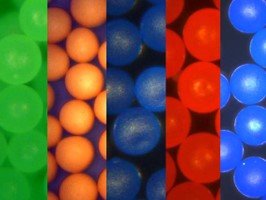
Does Density of Microspheres Matter?
There are a lot of variables for the researcher to consider when selecting the right material for their project. What properties of the material are critical? Particle size? Formulation? Color? Fluorescence? Phosphorescence? Coating? Reflective Index?
Our technical support team starts by asking two questions:
1 - Do you need a particle of specific diameter?
2 - Do you need a particle of specific density?
Typically, researchers have a good idea of what size particles they need to work with,
but many misunderstand how critical density is to the success of their project.
When is particle density important?
Density controls the buoyancy of an object and its behavior in a system or process.
Let's look at three scenarios:
- Scientists often need to suspend the particles in a specific fluid (to stay suspended, to float, or to sink). In this situation the delta between the densities of the particle and of the fluid need to be precisely controlled. If there is a mismatch in density, the microspheres will either sink or float. The smaller the microspheres the less sensitive they are to the density mismatch. For larger microspheres (such as close to 1mm in diameter) to stay suspended for some time, the density delta needs to be at most 0.001g/cc. Even slight changes in the temperature of the fluid might change its density and determine whether the particles will stay suspended.
- Scientists are studying fluid flow, performing flow visualizations, or particle image velocimetry.
The particles are used as flow tracers or seeding particles and must be clearly visible as they follow the flow of the fluid. In these applications, not only does the density of the particle needs to match the density of the fluid exactly, the particle needs to also be small enough to stay suspended, and be color-stable and visible to the observer under the specified illumination (laser, UV light, daylight, etc).
- Scientists are simulating/modeling objects with specific density. Whether studying the flow of fish eggs in a stream, the spread of pollen in forest, or the flow of semen in artificial insemination, many experiments start with a computer model that is based on an assumption of a spherical particle of specific density. Being able to obtain such particles to test and validate the model is often a key step towards understanding the process and making breakthroughs in understanding how our world functions.
Cospheric products are unique because every product we manufacture is produced and qualified to a specific density grade and tolerance. Density of every lot of material is thoroughly characterized with our proprietary process prior to being offered for sale.
 Density Marker Beads - Precision Density Spheres, Microspheres
Density Marker Beads - Precision Density Spheres, Microspheres
Density Marker Beads are small colored microspheres of known mass density that are used for calibrating density gradients and determining density in gradient columns. Density gradient are often used for separation and purification of cells, viruses and subcellular particles. Generally, a set of several density marker beads covering a range of densities used.
The gradient is calibrated with beads that float at different heights within the column. When a test sample is added to the column, it drops until the point
of natural buoyancy and the density is determined from the calibration chart. Density gradient column can be used to measure the density of any sample.
Density Marker Beads are engineered for exceptional precision and uniformity of true particle density. These specialized microspheres pass much tighter density tolerances than any other microspheres on the global marketplace
and are often used as density standards for calibration or creating of density
gradients.
Cospheric Density Marker Beads are spherical particles of diameter between 200micron and 300micron. There are seven unique color-density combinations, provided in an aqueous solution (20% concentration). Density marker beads are ready for use right out of the vial.
Ask a Scientist:
Q: What is the difference between bulk and true particle density? Which one matters to me?
A: Bulk density (or tapped density) of powders is often referenced in literature but is not an intrinsic property of material and can be misleading. The reason for this is that bulk density can vary widely depending on the packing efficiency of material and can change over time as the powder settles in the container and the volume it occupies becomes smaller while the weight stays the same.
True particle density (or skeletal density) specifies the unique density of the material that the particles are made of. When properly measured, it is a characteristic property of material. This allows scientists and engineers to accurately model and predict performance of these particles in specific applications.
All Cospheric particles are characterized for true particle density by utilizing our proprietary density measurement technique which relies on NIST-calibrated gas pycnometry and high precision NIST-calibrated scale. To best support our customers' research needs, every Cospheric product offered for sale is listed on our website with true particle density as part of product description.
PDF version of the newsletter